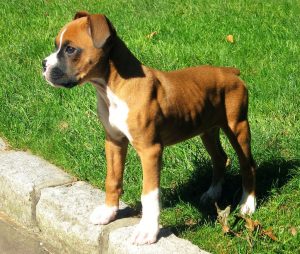 Boxers make excellent family dogs that enjoy being active with human companions. This breed performs well at dog shows after receiving proper training. Many boxers are trained to become service dogs for people with physical and intellectual disabilities. Like any dog, boxers will need house, leash, and obedience training. Learn more about boxer training to discover how you can help your dog transition into a new home.
Boxers make excellent family dogs that enjoy being active with human companions. This breed performs well at dog shows after receiving proper training. Many boxers are trained to become service dogs for people with physical and intellectual disabilities. Like any dog, boxers will need house, leash, and obedience training. Learn more about boxer training to discover how you can help your dog transition into a new home.
Start Boxer Training Early
It’s important to train boxers when they are puppies to ensure they grow up to be obedient adult dogs. Boxers can be a stubborn breed and often have a mind of their own. This highly energic breed requires daily exercise. Boxers are known to be jumpers, but this breed learns obedience commands very well. Harsh discipline is not recommended for this breed. Boxers respond well to positive and reward based training methods. Professional trainers use praise, encouragement, and repetition to help boxers become obedient dogs.
House Training Your Boxer
Pet Owners can easily train their boxer by practicing patience and positive reinforcement. A dog cannot be house trained overnight. Harsh training methods might cause your boxer to become frustrated and confused.
It’s important to put your boxer on a consistent feeding schedule. Removing food between meals can help prevent accidents and weight gain. It might be necessary to visit a veterinarian or change your dog food if frequent urination becomes a problem.
Responsible pet ownership can prevent your dog from having accidents in the house. Boxers should be taken outside at least 4 times a day. It’s especially important to take your dog outside in the morning and later in the evening. It’s helpful to look for signs that your dog needs to go outside such as barking, pacing, or scratching the door.
Crating is one of the best ways to house train your boxer. Although the concept might seem cruel, it will teach your dog to only urinate outside. Many pet owners crate their dog when no one is home to supervise the animal. A crate should be large enough for the dog to lay down, but small enough to prevent the dog from urinating in another area.
Pet owners should avoid certain training techniques and behaviors. Proper box training discourages yelling, hitting, and rubbing your dog’s nose in waste. Although crating is a good house training technique, crate time should be limited. People should use pet cleaners instead of ammonia-based cleaners. It’s also a good idea to let your boxer enjoy being outdoors after urinating with a walk or game of fetch.
Leash Training Your Boxer
Leash training your dog is necessary for walks and trips to the veterinarian. An untrained dog will frequently jump and pull on a leash. No-pull harnesses, head halters, and positive reinforcement are effective techniques of boxer training.
A no-pull harness is an excellent way to teach your boxer not to pull on a leash. Another great leash training technique is putting a head halter over a dog’s snout. The halter will turn the dog’s head down and sideways when it pulls on the leash.
The “penalty yard” method is another technique used to leash train your dog. Professional trainers recommend stopping and backing up three feet when a dog pulls on the leash. Pet owners should not allow the dog to walk forward until the leash becomes loose.
It’s important to use positive reinforcement when leash training your boxer. Pet owners should praise their dog by telling them they are doing a good job. Giving your dog treats during walks is another positive reinforcement technique. It’s best to avoid giving a treat immediately after the leash is released. Treats should be given randomly throughout the walk.
Boxers are wonderful companions that can be easily trained with patience and positive reinforcement. It’s essential to begin boxer training as soon as possible. Crating is one of the best ways to house train your dog. No-pull harnesses and head halters can be useful leash training techniques. It’s also important to use positive reinforcement and avoid harsh discipline.
 Because they were originally bred as fighting animals, boxers are courageous, stubborn, and cunning. These specific boxer temperament traits led them to become interesting and often amusing pets. They love fun, are a very active and loyal breed, and they are highly intelligent. Source:
Because they were originally bred as fighting animals, boxers are courageous, stubborn, and cunning. These specific boxer temperament traits led them to become interesting and often amusing pets. They love fun, are a very active and loyal breed, and they are highly intelligent. Source:  The mini boxer is a hybrid dog. Hybrid dogs are created when two purebred canines, from different groups or classes, breed to create a new standard with positive characteristic from both lines. This mini line is a cross between the American boston terrier, which has been around for 125 years, and the boxer, originally from Germany.
The mini boxer is a hybrid dog. Hybrid dogs are created when two purebred canines, from different groups or classes, breed to create a new standard with positive characteristic from both lines. This mini line is a cross between the American boston terrier, which has been around for 125 years, and the boxer, originally from Germany.






